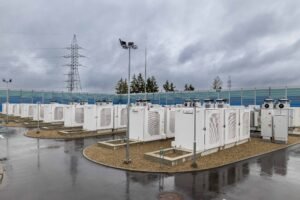Lithuanian Parliament to Consider Amendments for Electricity System Balancing Services

The Parliament of the Republic of Lithuania will consider legislative amendments enabling Lithuania’s electricity transmission system operator “Litgrid” to temporarily procure a small share of balancing services necessary for electricity system management from the energy storage system operator “Energy cells” after the synchronous connection with the Continental European grid, scheduled for February 9, 2025.
Baltic States’ Transition to the Continental European Grid and the Role of “Energy cells” in Balancing Services
In February 2025, with the Baltic States disconnecting from the Russia-controlled IPS/UPS system and synchronously joining the Continental European grid, Lithuania, Latvia, and Estonia will be responsible for independently balancing electricity production and consumption within their networks. A joint Baltic balancing capacity market will be launched, requiring sufficient flexible devices for effective operation. Until such devices and capacities are developed in the market, it is planned to temporarily procure part of the necessary balancing services from “Energy cells,” which manages a 200 MW energy storage battery system and provides isolated operation reserve services.“To ensure the reliable operation of the electricity system and reduce costs for end users, part of the balancing services could be procured from ‘Energy cells,’ while ensuring that the company continues to provide critical isolated operation reserve services for the transmission system. Energy storage systems are the most cost-effective and efficient way to balance the electricity system, so we eagerly await the launch of new storage projects that will provide these services. As new storage facilities are connected, the share of balancing services procured from ‘Energy cells’ will decrease proportionally, and once there is sufficient market supply, the services will be exclusively purchased from other market participants,” said Donatas Matelionis, Head of the System Management Department at “Litgrid.”
Legislative Amendments and the Role of “Energy cells” in Providing Balancing Services in the Energy Market
The possibility of procuring balancing services from “Energy cells” is outlined in the amendments to the Electricity Energy Law and Synchronization Law under consideration by the Lithuanian Parliament. These amendments implement the provisions of EU Directive 2019/944 on common rules for the internal electricity market, which allow system operators or their related companies to provide balancing services. The Directive acknowledges that Baltic States, being reliant on the Russian synchronous zone for frequency regulation, have not yet established fully functioning balancing markets and face specific challenges in organizing them. Adequate balancing capacity reserves for frequency regulation are essential for the stable operation of the synchronized system. This exception will apply not only to Lithuania but also to Latvia and Estonia.The operation of “Energy cells” services will be defined by the adopted legal amendments, decisions of the European Commission, and the contract between “Litgrid” and “Energy cells,” which will be approved by the National Energy Regulatory Council (VERT). The contract is expected to be finalized in January and will be made publicly available. It is planned that in 2025, “Energy cells” will provide 40 MW of capacity for the balancing capacity market and participate in the balancing energy market, where their offers will be placed at the end of the auction queue, meaning “Energy cells” resources will only be activated if other market participants cannot provide the services.
Forecast of Balancing Capacity Demand and the Role of “Energy cells” in the Baltic States’ Power System
The total balancing capacity market demand in the Baltic States is expected to reach approximately 1,500 MW in 2025, including 23 MW for Frequency Containment Reserve (FCR), 90–120 MW for automatic Frequency Restoration Reserve (aFRR), and 600–770 MW for manual Frequency Restoration Reserve (mFRR) for upward activation and 370–610 MW for downward activation. According to Baltic operators, the balancing capacities of system operators and related companies (including “Energy cells”) will cover about 30% of the demand in 2025, with approximately 70% being procured from the market.According to “Litgrid,” considering the currently ongoing energy storage projects in Lithuania, “Energy cells” balancing services might be required for the next two years. However, starting in 2026, depending on market development, their use might decrease significantly.The primary goal of the energy storage system operator “Energy cells” will remain providing isolated operation reserve services essential for electricity system security. During the project implementation, the company tested functionalities required for balancing, as mandated by European Commission conditions and “Litgrid” connection requirements. With additional control center functionalities, “Energy cells” can temporarily contribute to addressing the 40 MW shortfall in balancing capacity by utilizing part of its system power.
According to “Litgrid,” there are currently 37 projects under development in Lithuania to connect energy storage facilities to the transmission grid, with a total capacity of approximately 1,052 MW and storage capacity of 2,710 MWh.
Lietuvosvalstybe.com
Sources: Ministry of Energy of the Republic of Lithuania
When quoting or distributing information from lietuvosvalstybe.com, it is necessary to provide a reference to the source of the information.

